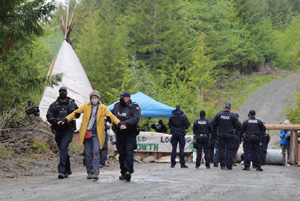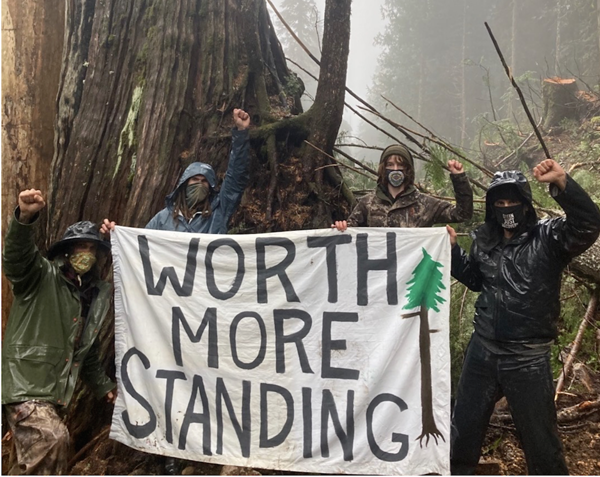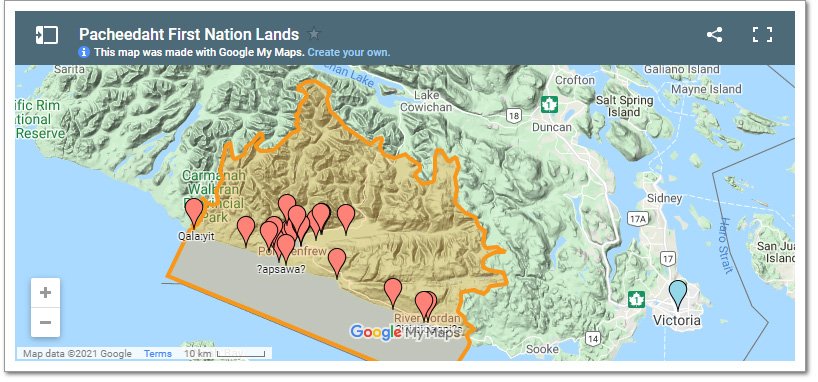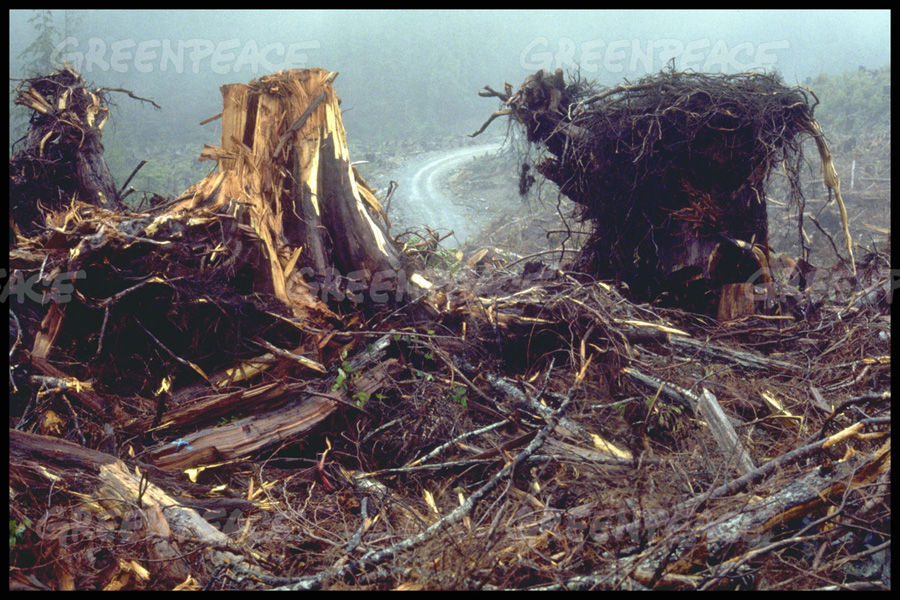
Thursday May 27, 2021 | VANCOUVER ISLAND, BC
by Jalen C Codrington | Island Social Trends
Since last summer, the Fairy Creek watershed has been a veritable battleground between environmental activists, loggers, and the provincial government. Protesters have been camped in forested areas between Port Renfrew and Lake Cowichan since August 2020, in an effort to protect the over 250-year-old forests from the operations of the Teal-Jones logging company.
In 2020, the provincial government granted Teal three permits to cut timber within specified areas of tree farm licence 46 (TFL 46). Of the portion of the Fairy Creek watershed lying within TFL 46, 74% (755 hectares out of the 1021 hectares) is unavailable for logging due to environmental constraints; 722 hectares are protected old-growth forest.
While most of the Fairy Creek watershed is in fact protected from logging, activists say that it is unacceptable even to log a small portion of the ancient land. The Rainforest Flying Squad (RFS), a grassroots coalition of activists dedicated to protecting old-growth forests on Vancouver Island wrote in a letter to the RCMP:
“This movement has become so much more than the trees – layered into it all are Indigenous rights, title and colonial expropriation, climate change, biodiversity, social and economic justice, corporate interests that have subverted the public interest, just to name a few. What we do here in this moment is going to ripple down through the generations.”

Within Pacheedaht First Nation:
TFL 46 lies within the traditional territory of the Pacheedaht First Nation. The First Nation owns three sawmills and has a revenue-sharing agreement with the province for logging on its traditional territory. The nation said the months-long protest is interfering with its ability to provide for community members and manage the delicate old-growth forest.
Some Pacheedaht hereditary chiefs and members, however, side with the protesters, which has caused a rift within the community. “The Fairy Creek watershed is a sacred place for many reasons,” said Bill Jones, a Pacheedaht elder, in a statement. “I have many stories about this area, from my own experiences as a child and young man and also stories that were told to me by my elders. It breaks my heart in half when I see these last remaining stands being ravaged so a few people can have jobs for a few more months.”

Injunction to Teal-Jones:
On April 1, B.C. Supreme Court Judge Frits Verhoeven granted a court injunction to Teal-Jones, prohibiting protestors from establishing roadblocks along the TFL 46, with orders for RCMP enforcement.
Defendants relied on expert opinion evidence from Drs. James Pojar and Peter Wood. Pojar, an ecologist, contended that there was not much old growth forest remaining, and that old growth forests are critical to combating the loss of ecological diversity and the climate crisis. Wood stated that logging in the Fairy Creek watershed brings increased risks of forest fires, flooding, landslides, and increases the risks of climate change.
Ultimately, Verhoeven ruled that if Teal-Jones is unable to log within the area of TFL 46, the company will not have an adequate timber supply for its mills. And if the company is forced to shut down its mills, it will be forced to layoff employees, and be unable to supply its customers with product. Therefore, Verhoeven decided it was contrary to the public interest to allow the protestors to continue with their blockade, and that irreparable harm would be done to the private logging company.
“The protesters are free to protest, demonstrate and attempt to influence the government in any lawful way they may choose,” said Verhoeven, “but no one has the right to disobey a court order, no matter how passionately they may believe in their cause.”
Designated protest space:
Since then, a designated space for protestors to peacefully assemble has been established by the Mounties. “This space will be suitably located to allow for peaceful, lawful and safe protest and be visible to employees of Teal-Cedar Products, their contractors, the police and media,” the RCMP said. “Persons found committing acts that breach the injunction order or whom are believed to have breached the injunction order, as well as persons refusing to leave the access control area, will be arrested.”
May long weekend action:
But the injunction hasn’t stopped protestors. Over the May long weekend (May 22-24), dozens of protestors were arrested, and that number is only expected to grow. People were seen blockading the logging roads, and chaining themselves to trees. One woman suspended herself in a makeshift wooden structure 30 metres off the ground.
Historical context:
The Fairy Creek conflict hearkens back to almost thirty years ago, when over 12,000 protestors gathered in the summer of 1993 to rally against Macmillan Bloedel’s clearcutting of the Clayoquot Sound. Protestors included members of the local Nuu-chah-nulth First Nations, as well as NDP MP Svend Robinson (who was sentenced to 14 days for criminal contempt of court), and environmental groups such as Greenpeace and Friends of Clayoquot Sound. Almost 1000 people were arrested. The protests received international mass media coverage, which helped create strong support for environmental groups in British Columbia, and foster advocacy for anti-logging campaigns. Despite being issued a court injunction intended to ensure loggers could continue their work, the protesters refused to move.
In 1995, after facing enormous boycotts, Macmillan Bloedel lost over $200 million in sale of timber products. As a result, it gradually removed itself from the Clayoquot Sound region, and turned over control of its tree farm license to the Nuu-chah-nulth First Nations. After enormous public pressure, and various recommendations from scientific panels, the B.C. Ministry of Forestry decided to end the clearcutting of the sound.
Today, most of the land remains unlogged, a seeming testament to the success of the protests. Before the movement, forestry was regarded as the backbone of B.C.’s economy. Since the mid-90’s, however, logging jobs and enrolment in forestry programs have been steadily declining.
One of the leaders of the Clayoquot protests, Tzeporah Berman, was jailed and charged with 857 counts of criminal aiding and abetting. Berman served on the British Columbia Governments Climate Leadership Team, and was appointed to serve on the Alberta Governments Oil Sands Advisory Group as co-chair in 2016. She was listed of one of the 35 Most Influential Women in British Columbia by B.C. Business Magazine, and awarded an Honorary Doctorate of Law from University of British Columbia.
Over the May long weekend just recently behind us, Berman was one of the many protestors arrested at the Fairy Creek blockade.
In the premier’s riding:
It’s worth noting that all of the Fairy Creek conflict is unfolding in Premier John Horgan’s own riding of Langford-Juan de Fuca. Despite NDP promises to protect forests, data suggests that old-growth logging approvals have increased by 43% this year.
Ultimately, the ball is in the premier’s court. He has had a positive long-time working relationship with the Pacheedaht First Nation located at the far tip of his large west shore riding, nurtured even during the early years as MLA (Horgan was first elected in 2005).
===== About the writer:
Jalen C Codrington is a fourth-year Philosophy student at the University of Victoria. In summer 2021, he is the Copy Desk editor with Island Social Trends.
===== Editor:
Mary P Brooke, Editor, Island Social Trends, has been covering the news of the Premier’s riding in Sooke, Langford and Juan de Fuca since 2008.






